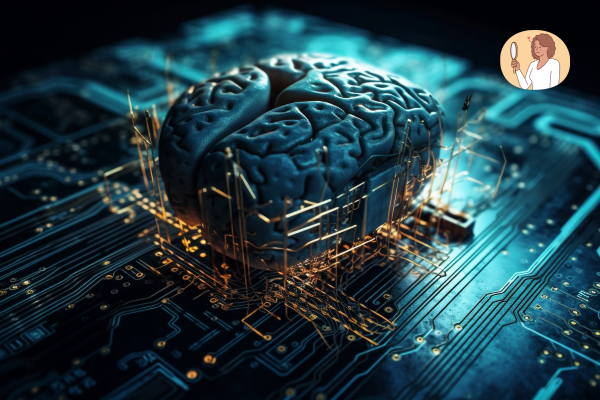Introduction
Deep learning is a sophisticated type of artificial intelligence in which computers learn new skills through extensive data analysis. Deep learning uses neural networks with many layers — hence the term “deep” — to learn from unstructured data, such as text, audio, and images, unlike classical machine learning, which relies on organized inputs and explicit programming. Deep learning is incredibly useful for applications such as picture and audio recognition, natural language processing, and more because of its ability to automatically extract features and representations from raw data. Everyday advancements that improve convenience, effectiveness, and general quality of life are powered by this technology.
Table of Contents
How deep learning works?

Deep learning is basically based on neural networks made up of multiple layers of connected nodes or neurons. After processing the incoming data and extracting its features, each layer passes the information to the next layer. The network is able to learn complex representations and patterns due to its hierarchical nature. Large datasets are fed into deep learning models during training, and connections between the model’s neurons are adjusted based on the output error until the model gives the correct predictions. Gradient descent and other optimization methods are used in this backpropagation process to minimize the error. Deep learning is very useful for difficult tasks because it can create models that are more accurate the more layers and data the model has.
Key Techniques and Algorithms in Deep Learning
To handle data efficiently, deep learning uses several important strategies and methods. Among the most important are:
- Convolutional Neural Nets (CNN) : Excellent for tasks involving recognition of images and videos. They are great for visual data as they employ convolutional layers to recognize elements such as edges and textures.
- Recurrent Neural Networks (RNN): Suitable for sequential data such as natural language and time series. RNNs can retain information across time steps due to their cycle-forming connections.
- .Generative Adversarial Networks (GANs) : These networks are used to create artificial data that is similar to the training data. A generator and a discriminator are the two networks that make up a GAN, and they compete with each other to be better.
- .Autoencoders: Used for noise reduction and data compression. By teaching the network to output similar data to that inputted, autoencoders teach the network efficient coding of the input data. This technique is often used for anomaly detection.
Popular Deep Learning Frameworks
Deep learning models can be implemented using several robust frameworks that are available:
- TensorFlow: It was created by Google and is used extensively for both production and research. TensorFlow provides complete tools and flexibility in the development and implementation of machine learning models.
- Keras: A high-level TensorFlow-based API that facilitates model building and training. Keras makes learning to code easier and more accessible for beginners.
- PyTorch: It was created by Facebook and is quite popular among researchers due to its adaptability and ease of use. Dynamic computation graphs are available in PyTorch and are useful for study and development.
- Coffee: It is often used in both industrial and academic applications due to its speed. Caffe is very useful for convolutional networks and the performance is optimized.
Applications of Deep Learning in Various Fields
Many fields can benefit from the many uses of deep learning.
- Healthcare: Predicting patient outcomes, optimizing treatment regimes, and improving diagnosis using image analysis. For example, deep learning systems have a high level of accuracy when identifying diseases such as cancer from medical photos.
- Automated Vehicles: The ability to perform object recognition and decision-making in real-time empowers autonomous vehicles. To travel safely, deep learning helps cars recognize objects, pedestrians, and traffic signals.
- Finance: Identifying fraudulent transactions, forecasting market movements, and mechanizing trading patterns. Deep learning is used by financial firms to evaluate massive amounts of data for risk assessment and decision making.
- Retail: Demand forecasting and customized recommendations improve the consumer experience. Retailers use deep learning to maximize inventory control and understand consumer preferences.
Business Impact of Deep Learning

Businesses are transforming because of deep learning’s ability to automate tedious activities, enhance decision-making, and foster innovation. Businesses use deep learning to improve operations, create new goods and services, and extract insights from large data sets. To boost consumer engagement and sales, deep learning models can, for example, analyze customer data to personalize marketing activities. Deep learning can enhance quality control in manufacturing by identifying product defects. Deep learning is also used by companies for predictive maintenance, which reduces operational expenses and downtime. Deep learning is an essential tool for contemporary businesses because of its ability to improve and automate a wide range of processes.
Deep Learning in Everyday Life
Deep learning has been integrated into many common technologies, such as:
- Voice Assistants: Deep learning is used by Google Assistant, Apple’s Siri, and Amazon’s Alexa to recognize voices and understand natural language. These assistants are multitasking and have the ability to understand and respond to consumer inquiries as well as operate smart home appliances.
- Image recognition: Deep learning is used on platforms including Facebook and Google Photos to identify and tag individuals in images. Systems that use face recognition for security and authentication are also powered by this technology.
- Recommended systems: Deep learning is used by Netflix, YouTube, and Spotify to recommend content based on user preferences. These technologies improve the user experience by making personalized suggestions based on analysis of viewing or listening habits.
The way deep learning is incorporated in these common applications shows how versatile the technology is and how it can improve usability and ease in our daily lives.
Challenges and Limitations of Deep Learning
Despite its capabilities, deep learning has several obstacles:
- Data Requirements: Large data sets, which can be challenging to collect, are required for deep learning models. Model performance is directly affected by the amount and quality of data.
- Computing Power: Deep learning model training requires large amounts of computing power and resources. For organizations with fewer resources, this can be a barrier.
- Understandability: Deep learning models are often referred to as “black boxes” because their decision-making process is difficult to explain. Understanding the logic behind a model’s decision-making is essential to foster trust and accountability.
- Concerns About Ethics: Deep learning methods raise questions about potential abuse and bias. Ensuring justice and resolving ethical concerns are essential for responsible AI deployment.
These issues will need to be addressed with more study, better tools, and ethical concerns to responsibly harness the full potential of deep learning.
Future of Deep Learning

The future of deep learning is bright. Research is now being done to improve the accessibility, interpretability, and efficiency of models. Deep learning’s capabilities will continue to be improved by hardware innovations such as specialized AI processors. In addition, new avenues will become possible when deep learning is combined with other cutting-edge technologies such as quantum computing and the Internet of Things (IoT). Privacy concerns are addressed by innovations such as federated learning, which enables models to learn from data at different sites without revealing the raw data. Advances in climate modeling, smart cities, and personalized treatments are anticipated as deep learning evolves.
Is deep learning easy to learn?
Deep learning can be difficult to learn due to its complexity and the need for extensive programming, mathematics, and domain-specific application expertise. Nevertheless, committed students can progressively increase their level of proficiency thanks to the abundance of online tutorials, courses, and resources available today. It is advisable to start with the fundamentals of machine learning and slowly delve into deep learning methods. The learning process can be accelerated by using community forums, practical projects, and online learning environments such as Coursera, edX, and Udacity. Deep learning is achievable for individuals who are dedicated to learning, but achieving mastery requires persistence and constant practice.
Conclusion
Deep learning is a game-changing technology that simulates how the human brain absorbs and processes information. Its uses are wide and profound, affecting many different fields and aspects of our daily lives. The potential benefits of deep learning make it an important area for future research and development, even if it has some obstacles. Deep learning will likely inspire more discoveries as the technology develops, improving many aspects of our lives and solving challenging issues that could not be solved in the past. Deep learning is an exciting and demanding field, and it holds great promise for the future of artificial intelligence and how it will shape our environment.
- You might be interested in reading these posts as well
- Quantum machine learning algorithms for drug discovery applications
- Machine learning algorithms for crop yield prediction
- Machine Learning Algorithms for Efficient Water Quality Prediction
- Machine Learning Optimization Algorithms & Portfolio Allocation
FAQs
Deep learning is a kind of machine learning that uses multi-layer neural networks for data analysis and learning.
Neural networks with linked neurons are used in deep learning. To provide accurate predictions, these networks collect features from the input and identify patterns by layer-by-layer processing.
Important deep learning techniques include autoencoders, generative adversarial networks (GAN), recurrent neural networks (RNN), and convolutional neural networks (CNN).
Several popular deep learning frameworks are PyTorch, Caffe, Keras and TensorFlow.
Deep learning applications are advancing and driving innovation in many fields, including healthcare, finance, retail and autonomous cars.
Deep learning has several drawbacks, such as the need for a lot of data and processing power, interpretability issues, and ethical dilemmas with bias and misuse.
Although Deep Learning can be challenging, anyone who is determined to study can do it with commitment and the abundance of materials available.